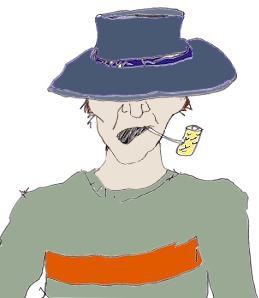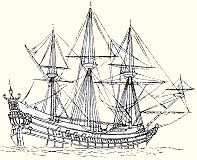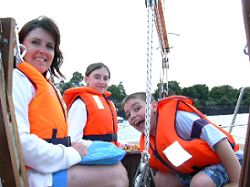

A place to share YOUR boat building story
Glen-L Marine Designs - 9152 Rosecrans Ave. - Bellflower, CA 90706

In this issue
-
Building the Glen-L Whitehall by Dave
Gillette
-
Feedback: Sculling Skiff by Mike Van
Susteren
-
Memories: Classic runabouts and my brother
Elbert by Glen Witt
-
Row Row Row Your Boat by ArtDeco
-
Photos sent in since the last WebLetter...
-
Tahoe Get-Around by Rich Coey
-
Shop Talk: Scarfing by Ken Schott
-
Recent email
GLEN-L Update
- Gathering update: Total coming re. Boatbuilder Connection
-
It's amazing what you can find in back copies of the WebLetter. I
didn't remember this at all.
From WebLetter 33: "I thought you might be interested in the version of the Amp Eater that I built to be both electric and steam powered. You can see her at http://www.geocities.com/katieanntoo/" ...Roger Ulsky
There is now a video of the Amp Eater under steam power. It would be neat to see one of the sailboats, like the Glen-L 17, set up for steam or electric power. - Forum outages... A couple of times this last month the Forum was down. The problem has been solved. It seems we had a program that was backing up 30MB per day to our server and at 875MB of backups, the server was full, which caused errors in the Forum.
Editor
Building the Glen-L Whitehall
by Dave Gillette
Early in 2004, I decided to pursue boat building as a fill in pastime, primarily for the downtime between our carpentry jobs. My wife Sue and I are finish carpenters, and especially during the winter months, find ourselves with time to kill. Having dealt with Glen-L back in the 70's while considering the building of the Klondike, they were the first place I checked for plans. Not wanting to jump into power boats right away, I was immediately drawn to the Whitehall; the lines are incredible, the size was appropriate for towing with practically any car, and with the multiple rowing stations, the possibility of longer boat rides with multiple persons to share the work seemed like an added benefit.
I sent for the plans, looked them over for a day or so, and ordered 200 bd. Ft of 4/4 Philippine mahogany and a couple of 16 ft planks of 8/4 for the heavier parts. While this order was being processed, my usual supplier for building materials was delivering the 2" x 6" stock for the building jig.
Feedback: Sculling Skiff
by Mike Van Susteren
The sculling skiff was completed and launched 15 months after I started the project (lots of down periods, believe me). I built the oars myself also which was a very interesting project in itself.
So how does it work? It's really, really cool! Pretty shaky at first, maybe 1 in 10 strokes were any good, but by day 3 things started coming together. Wow, it glides so smoothly and every stroke seems so efficient, it is almost effortless to move swiftly across the water. It takes loads of concentration to keep it straight and to keep all of your movements coordinated but when you do it is very rewarding. I haven't tried getting into it from deep water and not sure that is possible, but will try that soon enough. It is very stable feeling when the oars are out, but if you pull them in and you're not moving... then it's a different story.
The boat with the seat arrangement weighs in at 55 lbs and the oars are 4.5 lbs each. A very rewarding project.
"The boat seats are complete! They will need some final adjustments before they are mounted to the flooring. The seats are actually a section of a 150 year old church pew from the church I attended as I grew up. I cut the church pew down into two seat sections and they refinished nicely. I think if you are out on the water on a Sunday morning it counts as a church service plus you can have communion anytime you bring along a bottle of wine! More updates to follow… the end is in site!" ...Rick “Skip” Canton (Building ZIP)
Row Row Row Your BoatConsider building a boat you can row. Rowboats are nice to look at. They can be made simple and functional or elegant and yacht-like. There are benefits to rowing too. It’s fun and good exercise. It’s quiet, ecologically sound and rowboats can often get into places a powered boat cannot go.
So seat yourself
Down the handles,
Slice the water
Now stroke again
The hull races forward
Smoothly you glide
On through the tide
Captain of your ship
One last suggestion …
-ArtDeco |
Photos sent in since the last WebLetter... |
Tahoe Get-Around
by Rich Coey
I am a member of the Northern California/Lake Tahoe Chapter of the ACBS. On July 14th my wife and I took our recently finished Monaco "REMINISCENT" on what they called a get-around on Lake Tahoe. At the start "THUNDERBIRD" (a 55 foot commuter with two 1000 hp Allison aircraft engines) came across the lake and met up with four of us near Meeks Bay. From there we all went clockwise around the lake making stops joining up with other boats. At the height of the cruise there were about twenty boats, what a sight! We continued around until we arrived at the Thunderbird Lodge where the Thunderbird docked in its boat house. After that we joined a group and continued the rest of the way around the lake.
We swapped cameras with a couple we met. Their boat was "RAZZMATAZZ" a 17 foot 1942 Chris-Craft Barrelstern. All you can see of their boat are bits and pieces as they took these pictures. It was a great day, and Reminiscent was a big hit, everywhere we stopped, even among these classic boats.

A lot of folks can't understand how we came to have an oil shortage. Well, there's a very simple answer... Nobody bothered to check the oil. We just didn't know we were getting low. The reason for that is purely geographical. Our OIL is located in Alaska, California, Coastal Florida, Coastal Louisiana, Kansas, Oklahoma, Pennsylvania and Texas... Our DIPSTICKS are located in Washington, DC. |
Shop Talk: Scarfing Plywood
by Ken Schott
I could not find much info, or pics, on scarfing plywood in the WebLetters, or any other place for that matter. I find lots of talk, but pics are worth a thousand words. I wish I had these pics before I started, it would have saved me a lot of time. I tried several methods to cut the wide ply scarfs. This is what worked the best for me.
More scarfing stuff...
Joining plywood to make longer sheets
Scarf Sled
Scarfing with a router

Recent email:
Subject: Re: Glen-L Order
Date: 26 July 2007
Hello, I believe I have already on your mailing list. This is my second set of plans from you. The first was a 14' wood runabout I purchased in 1958 when I was a junior in High School and cut everything out in woodshop. I got a B+ on the boat. Not to Shabby for a 16 year old.
Subject: The New Boat
Date: 24 July 2007
From: Ken Schott
The pleasure of owning a boat.
Subject: RE: boat registry
Date: 18 July 2007
Gayle/Barry,
Attached are some pictures of my Imp project. This was
a lot of fun, and I look forward to doing another.
I'm not a pro, but I'm pretty proud of the way this boat came
out. Thanks for the awesome plans, and hopefully one of these pictures
can make your website.
Thanks Again,
Tom Schultz
Deep River, Ct
Subject: Glen-L Order
Date: 5 July 2007
Hi Gayle, I received the book. Thank you so much. Very good quality,
great customer service and fast shipping: I can't ask for
more!!!!!!!!
Thanks again.
Kind regards,
Daniel Skira
Subject: Re: Glen-L Newsletter
Date: 28 June 2007
Gayle
Thank you very much for the newsletter. It is very good and you are
doing a good job! Keep them coming!
Sincerely,
Robert Roma
Subject: Politics and boatbuilding
Date: Friday, June 29, 2007
Hi
As always I enjoy your new WebLetters and it's fun to read about
other builders, boat shows also. And the pictures, I love the pictures!
In the last WebLetter (90) there is also a link to an anti-Chinese
website. I must say I didn't enjoy this in the same way.
I'm not Chinese, and I don't agree with Chinese government and their lack of respect for human rights. There are many things I don't like about Chinese business morality and ethics. But who should throw the first stone...?
China has passed US when it comes to C02 polution. But on the other hand, divided by the population, each Chinese citizen polutes 1/8th as much as the average American. The American people are still the worst poluters in the world. And the US is constantly vetoing all attempts to make binding agreements.
China has ocupied Tibet. According to the Arabic world, the US has occupied Iraq! About 100,000 Iraqis has died since the occupation took place. The US has also lost military troops, but relativly few compared to the Iraqi civilian population. But of course the US has a god-given right to be world police and bomb everybody that has another political agenda than the present administration, back to the stoneage.
The US government has no respect for human rights when it comes to non-US citizens, as we have all seen from Abu Ghraib, Guantanamo Bay, and the procedure of shipping prisoners to "friendly" nations such as Saudi-Arabia, who have a view of torture that suits the CIA. And the US is still the only western nation who kills its own citizens in the old eye-for-an-eye method of the death-penalty. Does this upset you in the same manner as the anti-Chinese campaign?
The Americans I have met have all been really nice people. I love the down-to-earth and laid-back attitude, where people can follow there dreams and wishes. The Chinese and Arab people I have been in contact with has also been nice. But part of the US foreign policy is in my view not good. Should the next WebLetter from Glen-L be addressing this issue, or should we all just leave the subject and concentrate on the one thing that unites us all?
I love to read and look at pictures of boatbuilding on your site, sent in from all over the world: New Zealand, Turkey, England, Norway, Chile... Everybody with a common interest in building boats and enjoying the freedom to be out on the sea or lake, and no segregation due to political standpoint, religion or skin color.
I hope you will continue with that, and leave the politics and ranting to other websites where each of us can express our viewpoints as we please.
It is not my intention to provoke or make anyone angry. As I grow older the world is no longer black and white. It is a world of colors. But politics is all about trying to argue in black and white. The tolerance of other views is low. So to implement a specific political view into the WebLetter can make some people feel upset. And I hope that was not the intention. Remember that your WebLetter is a "universal publication" :)
(Sorry for all the misspellings, too many years since my last English-lesson. I hope you understand most of it :)
Take care, I wish you all the best.
Regards
Roy Hauge
I had wondered whether I should have put that link in. It wasn't an anti-Chinese "site", but it was an article critical of China and asking whether we should continue to do business with China. I have removed the link from WebLetter 90, but if you're interested, this is the link. brw
Subject: Tango, Kevin Gough
Date: June 25, 2007
Dear Gayle, Glen & Barry

I'm just about having as much fun as I believe can be had with a
sailboat! My deepest thanks and appreciation for all the effort that must
have gone into designing such a wonderful boat. Spirit has taken on quite
a lot of weather now and has always retained the air of a safe and sturdy
little vessel. Wherever I tie up I am always greeted by comments of how
beautiful she looks. I tell them I got the plans off your website and
built her from scratch and they just look at her with disbelief.
This year I have made a few changes... and I've detailed them on the
website...
http://web.mac.com/kevingough1/iWeb/Spirit/Welcome.html
Thank you and Best Wishes.
Kevin Gough
Build more boats
GLEN-L boats, of course


















